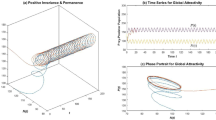Abstract
In this paper we build a prey–predator model with discrete weight structure for the predator. This model will conserve the number of individuals and the biomass and both growth and reproduction of the predator will depend on the food ingested. Moreover the model allows cannibalism which means that the predator can eat the prey but also other predators. We will focus on a simple version with two weight classes or stage (larvae and adults) and present some general mathematical results. In the last part, we will assume that the dynamics of the prey is fast compared to the predator’s one to go further in the results and eventually conclude that under some conditions, cannibalism can stabilize the system: more precisely, an unstable equilibrium without cannibalism will become almost globally stable with some cannibalism. Some numerical simulations are done to illustrate this result.







Similar content being viewed by others
References
Benoît E (1983) Systèmes lents-rapides dans \({\mathbb{R}^{3}}\) et leurs canards. In: Troisième rencontre du Schnepfenried, Société mathématique de France. astérisque volume 109–110(2):159–191
Benoît E, Rochet MJ (2004) A continuous model of biomass size spectra governed by predation and the effects of fishing on them. J Theor Biol 226(1):9–21
Birkhead T, Lee K, Young P (1988) Sexual cannibalism in the praying mantis hierodula membranacea. Behaviour 106(1–2):112–118
Claessen D, de Roos A, Persson L (2004) Population dynamic theory of size-dependent cannibalism. Proc R Soc Lon Ser B: Biol Sci 271(1537): 333–340
Elgar MA, Nash DR (1988) Sexual cannibalism in the garden spider araneus diadematus. Anim Behav 36(5):1511–1517
Farkas J, Hagen T (2007) Stability and regularity results for a size-structured population model. J Math Anal Appl 328(1):119–136
Gallucci F, Őlafsson E (2007) Cannibalistic behaviour of rock-pool copepods: an experimental approach for space, food and kinship. J Exp Mar Biol Ecol 342(2):325–331
Hirsch MW, Smale S (1974) Differential equations, dynamical systems, and linear algebra. Academic Press, New York
Kaewmanee C, Tang I (2003) Cannibalism in an age-structured predator-prey system. Ecol Model 167(3):213–220
Kohlmeier C, Ebenhöh W (1995) The stabilizing role of cannibalism in a predator-prey system. Bull Math Biol 57:401–411
Liu W, Xiao D, Yi Y (2003) Relaxation oscillations in a class of predator-prey systems. J Differ Equ 188(1):306–331
Magnússon KG (1999) Destabilizing effect of cannibalism on a structured predator-prey system. Math Biosci 155(1):61–75
Maury O, Faugeras B, Shin YJ, Poggiale JC, Ari TB, Marsac F (2007) Modeling environmental effects on the size-structured energy flow through marine ecosystems. part 1: the model. Prog Oceanogr 74(4):479–499
O’Malley R (1991) Singular perturbation methods for ordinary differential equations. Applied mathematical sciences, Berlin, Springer
Riley GA (1946) Factors controlling phytoplankton populations on Georges Bank. J Mar Res 6(1):54–73
Rinaldi S, Muratori S (1992) Slow-fast limit cycles in predator-prey models. Ecol Model 61(3–4):287–308
de Roos A, Schellekens T, Kooten TV, Wolfshaar KVD, Claessen D, Persson L (2008) Simplifying a physiologically structured population model to a stage-structured biomass model. Theor Popul Biol 73(1):47–62
Tuljapurkar S, Caswell H (1997) Structured-population models in marine, terrestrial, and freshwater systems, vol 18. Kluwer Academic Publisher, Dordrecht
Author information
Authors and Affiliations
Corresponding author
Rights and permissions
About this article
Cite this article
Rault, J., Benoît, E. & Gouzé, JL. Stabilizing Effect of Cannibalism in a Two Stages Population Model. Acta Biotheor 61, 119–139 (2013). https://doi.org/10.1007/s10441-013-9172-x
Received:
Accepted:
Published:
Issue Date:
DOI: https://doi.org/10.1007/s10441-013-9172-x




